

This page last modified: 13 November, 2013 (SON-9a & SA-8b added; S-60 updated).

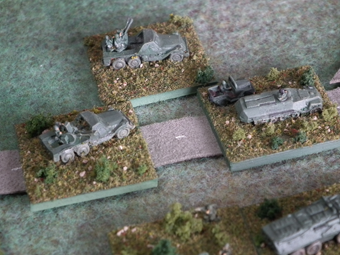
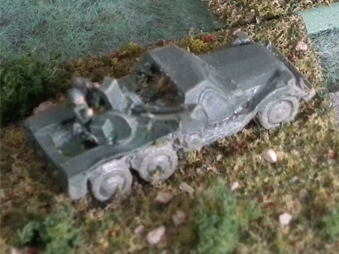
Above to the left is a regimental anti-aircraft company escorting the Divisional
HQ element. The HQ is in an OT-810, along with a GAZ-69 to help make clear it is an HQ stand, as opposed to an artillery oberver. The vz.53/59 Praga AA vehicles are made by cutting off the rear troop compartment from a Heroics & Ros BTR-152, and sticking a ZU-23-2 on the back, minus its wheels and mudguards, and adding a box for the ammunition container on top of the guns. As can be seen from the close-up on the right, the whole thing is rather under-scale (in particular, the vz.53/59 has twin 30 mm guns modified to fire even heavier ammunition than that fired by the standard vz.53 twin 30 mm AA guns, which means that the guns look decidely too small), and it lacks the curved body panelling around the gun "turret" of the original, but it still provides a reasonable approximation on the table top.
In game terms, these lack radar, so their AA factors aren't high, just a very ordinary 2, and they don't come too cheap either in terms of points, since they are still quite good at busting up enemy APCs. The Czechoslovakian army didn't to use the WarPac-standard ZSU-23-4, since they considered the vz.53/59 to be good enough that the extra expense of the ZSU-23-4 wasn't worth it. Consequently they stayed on in service right through the end of the Cold War. They do have one advantage in-game due to their lack of radar: being undetectable to enemy EW missions.

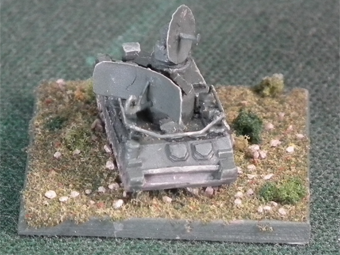
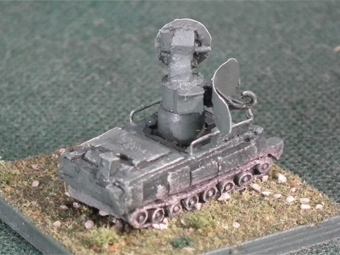
Above left is a not so-exciting picture of a 2K12 Kub, known as the SA-6 Gainful in NATO parlance. The Czechoslovakian 3rd Division that I usually model, being a second echelon formation, wasn't equipped with these at any stage of its existence, and had to make do with 57 mm towed anti-aircraft guns. First echelon divisions, such as the 20th Motorized Infantry Division, traded in their 57 mm guns for SA-6s starting from 1978, except for the 1st Tank Division, which received SA-8 instead. A missile-armed regiment had some 5 batteries, so that's quite a lot of vehicles (though in MSH, there is no need to represent the radar or resupply vehicles, etc., just the firing platforms). My vehicles are therefore mostly for when I want to "upgrade" to a first echelon force, like the 20th.
Nonetheless, the 3rd Division does have access to SA-6s - as Army-level assets, because the 4th Army's 251st AA regiment had them from 1975. The MSH rules encourage both on and off-table vehicle missile launchers to be fielded simultaneously (since they can give a cumulative -1 penalty to enemy aircraft attack runs). However, my SA-6s are less likely to see use than might be anticipated, simply because there are also a few Front-level SA-4 batteries available to the army. The SA-4 has the same AA factor (a 4) as the SA-6, but has a vastly greater range. This extra range is important, since the SA-6 is vulnerable to being located by enemy EW, and then smashed by long-range artillery, such as M107s. SA-4s have no such fears, since no artillery piece comes even close to matching their range. Despite this immunity to artillery attack, under the points system used by Keith's Scenario generator, they cost no more points (32) than an SA-6 does, so why (in gaming terms) would you use the SA-6?
To the centre and right is a 1S19 fire control radar vehicle (aka "Straight Flush"), one of which accompanied each real-life battery of 5 TELs (transporter erector launchers), but which isn't represented in MSH. The main body of this model is an H&R SA-6, with all the radars etc. being added by me. The missiles from the H&R model were used to equip my 9T22B reload-transporter model (see further down the page).
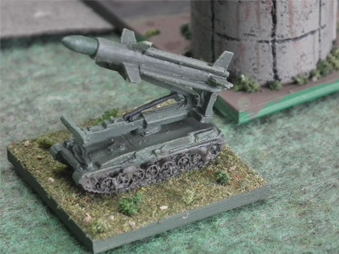
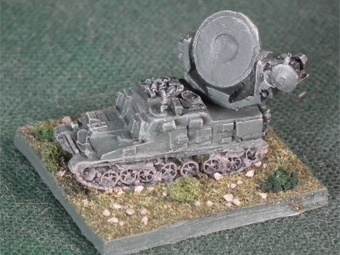
And here, on the left, is an SA-4, or more properly, a 2K11M Krug. This is a Scotia model. The more mathematically inclined of you might be wondering about the number of missiles here... I hope they normally supply two with the model, but mine only came with one. As such it looks like it might topple over in a strong wind, since the missile is huuuuuuge (each one weighs in at 2.5 tons!). Of course it has to be to get the range it does. Most people who model SA-4s seem to paint them with the missiles in silver or something equally flash; not a sensible idea on an actual battlefield, of course.
To the right is a 1S32 (aka "Pat Hand") fire-control radar vehicle; each Krug battery had one of these. This is also a Scotia model. Again, it's not actually used for anything under the MSH rules; but then neither is the TEL itself, since an SA-4 battery will inevitably be employed "off-table" in a game...
The Czechoslovakians had just a single brigade equipped with SA-4, serving on the Western Front (the 82nd). It was divided into three batteries, the 183rd, 185th, and 187th, each of which counts as having 3 stands of SA-4 in MSH terms (each battery also had some vz.53/59 vehicles to deal with close-in threats). This is therefore enough for each of Czechoslovakian Division to be allocated its own SA-4 stand in game terms, so there is no "cheese" involved in selecting an SA-4 as your off-table AA asset instead of an SA-6. What it also means is that you can then move all your SA-6s on-table if need be: in MSH on-table vehicle-launched missile AA only impart a -1 tactical factor to enemy aircraft if within 30" (reduced to just 20" at the ca. 1:5000 scale that I sometimes play at), so you need a lot of them to saturate the entire board.
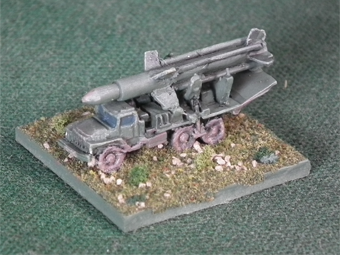
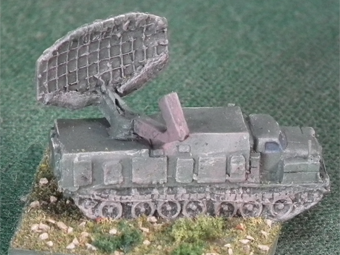
To the left is a 2T6 transloader vehicle, based an a Ural-375 truck, also by Scotia. Once I discovered that my SA-4 was missing a missile, and Scotia make a 2T6, well, I just had to buy it... It's a shame Scotia don't also do the SA-6 equivalent, the 2T7M, based on the ZIL-131. The 2K11 Krug system had a similar missile transloader plus missile transporter system to the 2K12 Kub system, and many other components of each system were either very similar to each other, or identical.
An example of such a shared asset is the rather large vehicle on the right: the 1S12 ("Long Track") target acquisition radar. This is also a Scotia model. The 1S12 is based on the AT-T heavy artillery tractor; it was used for long-range target acquisition, and was the first self-propelled target acquisition system that the Soviets put into service. In 2K12 (SA-6) units it was only used at regimental level, but at battery-level for SA-4 units.
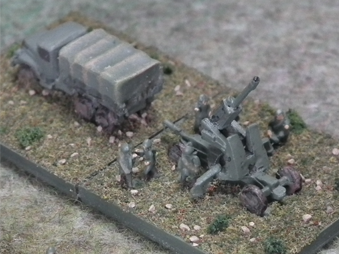
Above left: a stand of of 85 mm anti-aircraft artillery along with (I think) a Zil-157 truck; Scotia models I believe (crew by H&R however: I bought one pack of Scotia artillery crew for a laugh. They are a scale 8'6" tall, with shoulders 4' across, making gorillas look very puny indeed...). Before the 4th Army's 251st AA Regiment re-equipped with SA-6s, in 1975, it operated PLK 85 mm anti-aircraft guns. Czechoslovakia also operated the 100 mm KS-19, and a very few (8) of the 130 mm KS-30, but these very heavy pieces were used to defend cities rather than operate in the field, and had been withdrawn in the 1960s when they were replaced by SA-2 SAMs. As with other WarPac nations, the Czechoslovakian air-defence force was a separate branch of the military, distinct from the air force.
Prior to 1975, the 251st had some thirty-six PLK 85 mm pieces on its books,
although a third of them were usually kept in storage as mobilization-only assets. As an army regiment, rather than an air-defence force brigade, it was expected to defend army assets rather than population centres. However, by the 1970s, it would have been virtually useless in that role; and although it was equipped with high-velocity guns that could be pressed into the anti-tank role in an emergency, it wouldn't have been very good at that either, as the 85 mm gun was far behind the times.
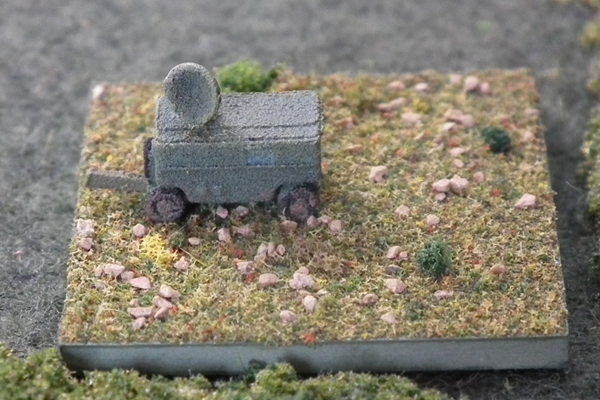
This is a SON-9A fire-control radar to accompany my 85 mm guns; the NATO reporting name is "Fire Can". This was the standard radar used for not only 85 mm AA guns, like the Soviet KS-12 and Czechoslovakian PLK-85, but also for 57 mm and 100 mm AA guns. This model is one of my own Shapeways creations. I couldn't find any scale diagrams for it, and had to estimate its dimensions from a few photographs - I suspect it is badly under-scale... Typically 2 firing platoons, each of 3 weapons, were controlled by a single radar. The SON-9A was later superseded by the RPK-1 radar, which was mounted on the roof of a URAL-375D truck. This particular model, as with all the stuff I have printed from Shapeways, is printed in the cheapest plastic they offer "white, soft, flexible", because I can't afford the better but more expensive plastics. As a result, not all the details on computer the model are visible "in the flesh", and the whole thing has a rather grainy appearance. But since the base is 30 mm square, the model is less than a centimetre long: the details - or lack of them - simply aren't visible at gaming distances...
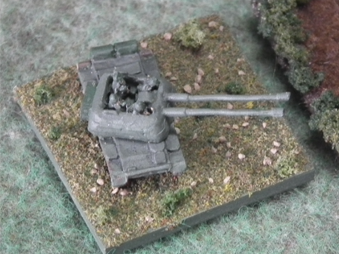
Here is a ZSU-57-2, with crew added from a Soviet artillery pack. The immense length of the 76.6 calibre 57 mm guns is readily appreciated from this photo - they have to be positioned carefully so that they don't overhang the base and get bent - keeping them straight is hard enough as it is! As I use 30 mm bases, they are 1.75 mm smaller than the bases most people use, which are 1 1/4" square. Inches are bad enough, but quarter inches? What a silly size :-)
The Czechoslovakians didn't use the ZSU-57-2; they apparently evaluated one, and
decided the vz.53/59 was at least as good. This model then, is used when I want
to field a Polish force from the 60s or 70s, as the Poles used the ZSU-57-2 for e.g. their tank regiments. Lacking any kind of radar, it has the same problems as the vz.53/59 in acquiring targets, compounded by a slower rate if fire. On the plus side, a single hit, if the crew were lucky enough to get one, ought to bring down most targets.

Here is a ZSU-23-4, which replaced the ZSU-57-2 in Polish service (the ZSU-23-4 was used by every WarPac nation except for Czechoslovakia, I believe). I use these for Polish forces from the 1970s or 80s. The vehicle is surprisingly large - to accommodate all that radar equipment, no doubt.
The introduction of the radar-equipped ZSU-23-4 should have given the Poles a
great advantage over the Czechoslovakians in terms of army AA assets,
but not all is as it seems. The Poles had less than two hundred of the
expensive ZSU-23-4s to go around an army 50% larger than that of
Czechoslovakians, who had approximately 900 much cheaper vz.53/59s (700 of which
were still in service in 1988). A 1970s Polish tank regiment had 4 ZSU-23-4s
(or ZSU-57-2s; and a very few were stuck with just towed ZU-23-2 like the Mechanized
(infantry) Regiments). Thus a Polish Division had just 4 SPAAG vehicles if
Mechanized, or 12 if Armoured. In contrast, all Czech regiments, tank and
rifles, had 8 vz.53/59s, with 12 more being found at divisional level, for a total of 44 per division, and they were found in other combat formations too. At least the Poles started using the SA-7 a whole decade before the Czechoslovakians did, in the early 70s as opposed to the early 80s. In MSH, the ZSU-23-4 is given an awesome anti-infantry factor, and their AT factor isn't too bad either, which makes them deadly against combat teams and anything on wheels, so they are likely to see some table-top action even if the enemy doesn't field any aircraft..
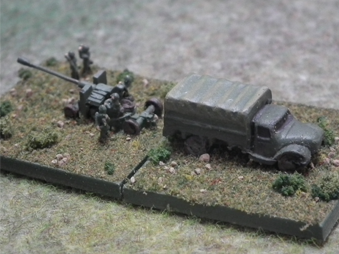
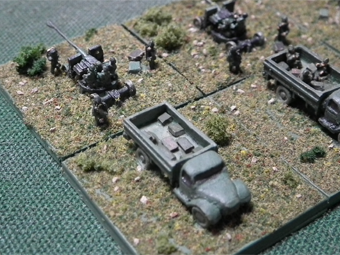
Shown above are some S-60 57 mm AA guns, plus associated trucks, from my 3rd
Division's 13th Anti-Sircraft Regiment. The S-60 is a Scotia model,
with H&R crew; the truck on the left is an H&R German WW2 Opel, numbers of which
were used by the Czechoslovakians post-war, although I doubt many, or indeed any, survived into the 70s. It does give the requisite antiquated feeling to the unit, however! The ones on the right may be some kind of Soviet truck by Scotia; I can't recall. The S-60 was used in first echelon units until replaced by SA-6s in the late 70 or early 80s; second echelon units like the 3rd Division often used the home-produced equivalent, the PLK-CS, and did so right through the 80s.
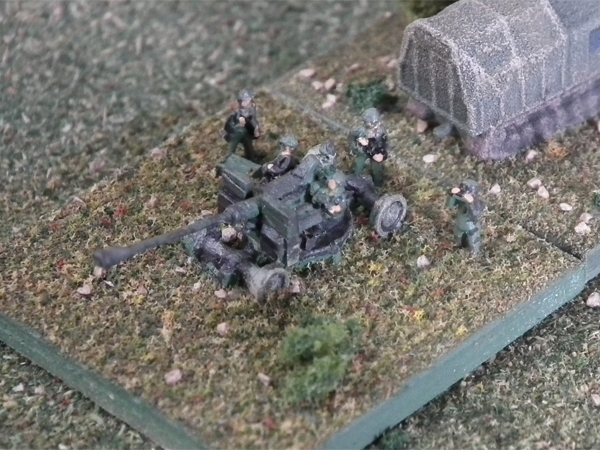
57 mm AA guns aren't actually much use on-table as AA pieces. They have the same
low AA factor (just 2) as the vz.53/59 despite having radar assistance (the
radar set-up usually isn't modelled on-table, but see my SON-9A above) with the twin disadvantages of being towed, so they have to be stationary to fire, and being detectable by enemy EW missions. And being 57 mm, their rate of fire isn't high enough for them to have much of an anti-infantry role either. On the plus size, they are very cheap in terms of points. A somewhat cheesy use for them on-table might be to bulk up a small but expensive battalion's size (such as a tank battalion), so long as you make sure the enemy never see them (or worse, flatten them with EW-directed artillery...). The model above is being towed by an AT-S tractor from Shapeways, which makes a much better towing vehicle than a 4-wheel truck.
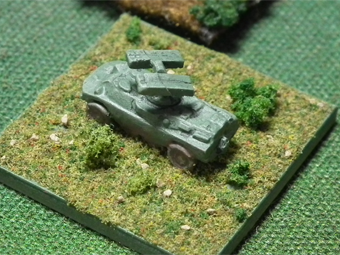
Here's a 9K31M Strela-1M, known as the SA-9b in NATO-speak. In the late 70s, the Czechoslovakians imported a single battery (4 vehicles) of these for evaluation purposes. They eventually decided not to purchase any more, and the battery eventually (in 1984) found its way to the 3rd Division, so I can field a single element of these from this date.
The model isn't one of H&R's best. The moulding details are getting a bit worn;
the launcher boxes aren't squarely rectangular, and the vehicle even the belly
wheels like other BRDM-2-based vehicles which, however, the real-life vehicle
lacked. In games terms, SA-9s aren't the best of AA vehicles, either. Their
first-generation missiles grant them an AA factor of only 3, just one better
than a puny shoulder-fired Strela-2 (SA-7b Grail). Nonetheless, their range is
sufficient to cover the entire board (on a standard 1800 by 1200 mm table) so
long as you don't wander too far into the flanks from the centre of the board,
which is something the otherwise better Strela-10 (SA-13 Gopher) has a harder time doing - an SA-13 positioned exactly at the centre of the table will still leave the corners uncovered at the reduced ground scale. But the real advantage of the SA-9 is it
doesn't have a radar associated with it, not even at battery level, so can't be
smashed by enemy EW-directed artillery strikes.
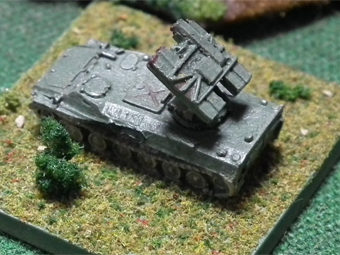
And here is a 9K35M Strela-10M, or SA-13 Gopher. These have a decent AA factor of 4, but their rather short range (5 km) translates to just under half a table width at the reduced scale I sometimes play at (1" = 125 m), so you really need two to cover the table in this case; things are somewhat better at "normal" scale. In Czechoslovakian hands, SA-13s were usually found in first-echelon Tank Divisions (the 1st and 9th), and not before 1983 at the earliest. Each regiment gets a single stand (the regimental AA company's other stand is a vz.53/59) representing 4 launcher vehicles.
The SA-13 was designed as a replacement for the SA-9, and like it, has a fully
capable passive detection system. However, one variant of the SA-13 has a range-only radar to aid target tracking, and this is the one modelled by the H&R model shown above - you can just see the tiny radar dish between the missile boxes. In addition, the vehicles can be patched into a battery radar system. Sounds good, but this causes immense in-game problems, because these things can be detected by enemy EW radar-detection missions. If you are facing a NATO-1 force like say the American 3rd Division, they can successfully pull off an EW mission on you 5 times out of 6 (in contrast, Czechoslovakians, being WARPAC-2, can do so only 1 time in 6)! And at a base 23 points per element, you can lose points very fast like this... all in all, I'd much rather take SA-9s if possible, which shows you the game system is somewhat broken here, given the SA-13 was designed as the SA-9s replacement. I don't think there is an option in-game to "not use radar", but there should be, even if it reduced the AA factor down to 3, like the SA-9.
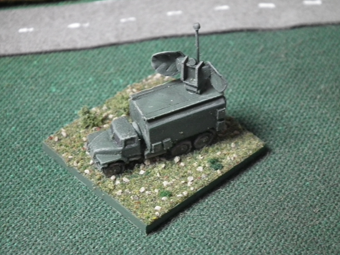
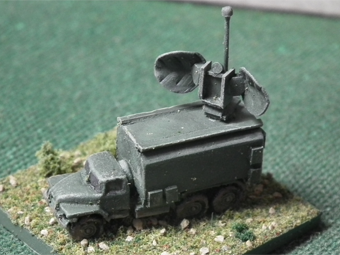
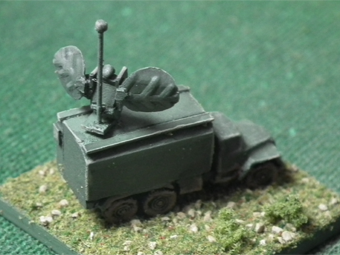
This is an SPN-30 radar jammer from the 4th Army's 4th Electronic Warfare Battalion, which was formed in 1978. With one battalion in each of the two Czechoslovakian ground Armies (1st and 4th), plus another held at front level, there were enough EW assets by this date for each division to be allocated a company's worth (each division had a more limited selection of its own organic EW assets as well, such as the radar and radio-interception vehicles in the divisional reconnaissance battalion's radio-surveying company). These vehicles and their EW capabilities are abstracted away in MSH into the various HQ elements, so this model is really just for show. Which is a shame, because I really like it...
The chassis is an H&R URAL-375 taken from a cannibalized BM-21 model. The truck body top is plasticard, as is half of the radio transmission gear mounted on top; the two parabolic "ears" are thin aluminium sheeting punched out with a 5 mm hole punch. The patterning on these was already embossed on them, as they were actually some "leaves" about 1 cm long from some toy-beads-and-sparkly-stuff set that my daughters have (and keep leaving around the place for me to stand on in my bare feet during the hot Japanese summer...). The SPN-30 is designed to jam airborne radars rather than jam enemy ground anti-aircraft radars, but there are no EW missions in the rules corresponding to this capability. A suitable house-rule would be something like "on a successful mission, enemy ARM- and SB-equipped attacks are at -1".
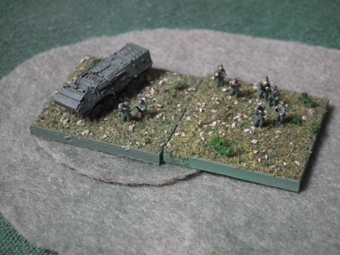
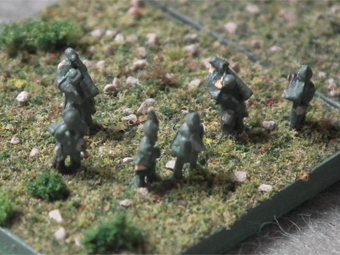
Here's a pair of battalion-level AA elements: OT-64-transported 9K32M teams, both mounted and dismounted. The 9K32M is known in the West as the SA-7b Grail, and was not used by the Czechoslovakians until very late by normal WarPac standards: my 3rd Division has to what until well into the 80s before it can field them. Unlike the Soviets, who deployed their SA-7s at platoon level in infantry companies, the Czechoslovakians consolidated theirs as a separate platoon at battalion level. In game terms this means Soviet infantry combat teams can all have an AA factor (albeit only factor 1, due to the limited number of teams), whereas Czechoslovakian ones do not; each battalion instead gets a single dedicated AA stand, but at factor 2. Before the SA-7 was introduced, this platoon was equipped with towed vz. 53 twin 30 mm guns.
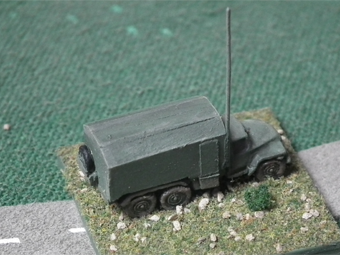
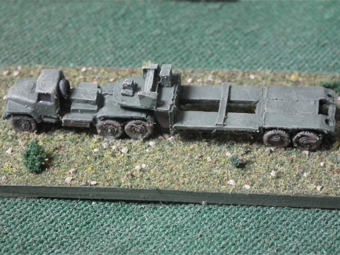

Above are a couple of elements that are not strictly AA vehicles, as such, but nonetheless belong to my 2K12M Kub (SA-6) regiment. On the left is my interpretation of a 9V88M1 radar testing rig. Air defence radars are complicated things, and need constant monitoring to ensure they are functioning properly, and that's what this vehicle is for. So this model has no real in-game purpose, other than looking interesting. Which is what it's all about really!
The thing in the centre looks like a tank transporter, but isn't, it's representing a 9T22B missile reload transporter. In combat, SA-6 reloads are carried on 6x6 ZiL-131 2T7M transloader trucks; each truck can carry 3 missiles, and has a crane to move the missiles onto the SA-6 launcher. The 9T22B transports missiles at a more operational level; it caries up to six of them that are then moved onto the 2T7Ms. On the right is the same vehicle, once I had found some missiles to stick on the thing taken from an SA-6 launcher.
The trucks for these models come from cannibalized H&R BM-21s. The body of the 9V88M1 is just thick plasticard glued together and cut and sanded to about the right shape. The flat bed of the 9T22B is a heavily modified flatbed taken from the H&R MAZ-537 tank transporter. The front end was cut off and replaced with an entirely new one made from plasticard, and the well deck was cut out, shortened, and raised up. This model also serves no real in-game purpose...

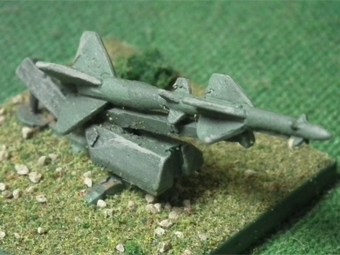
This is an S-75M, or SA-2d Guideline in NATO-speak, from the 2nd Battery of the 185th Anti-Aircraft Missile Regiment. The SA-2 is semi-mobile in that it can be transported, but only given several hours to deploy it. I'm not sure if they were ever moved in Czechoslovakian service. They are area-defence systems, designed to protect population centres rather than military assets (that was a job for the far more mobile SA-4s and SA-6s), so shouldn't be used in any attacking game scenario. But being a rather old system, their range isn't all that great: about 35 km; better than an SA-6 to be sure, but not as good as an SA-4. Nonetheless, it's enough to escape being targeted by pesky M107s. With an AA factor of only 3, they aren't very capable of shooting things down very easily either, so its main virtue is the -1 tactical factor it bestows on enemy airplanes.
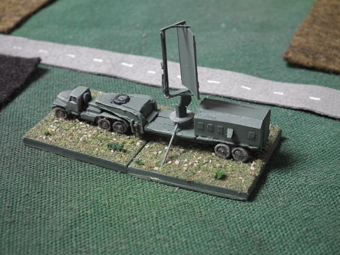
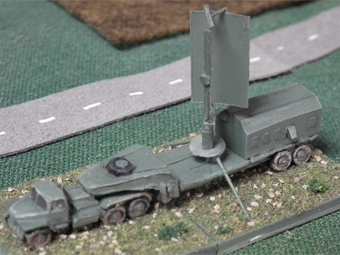
This large trailer is an ST-68, or "Tin Shield" radar to NATO. The trailer is again a hacked-up H&R MAZ-537 tank transporter, with plasticard fittings. The ST-68 is a component of the S-300PMU missile system (SA-10f Grumble), which was only introduced into Czechoslovakian service in 1990, outside my time period (just a single battery passed into Slovakian service). Hence this vehicle is here to symbolize when my Czechoslovakian forces operating under the anti-aircraft umbrella of the Soviet Central Group of Forces (who had either this or a similar system from 1982, I believe, but possibly as early as 1979, although these would have been earlier models than the SA-10f): the Czechoslovakian 20th Division, reinforced with one regiment from the 19th Division, was earmarked to operate defensively in conjunction with the Central Group of Forces in event of hostilities. An SA-10, like the more mobile but shorter range SA-12, has an AA factor 5: very nasty.
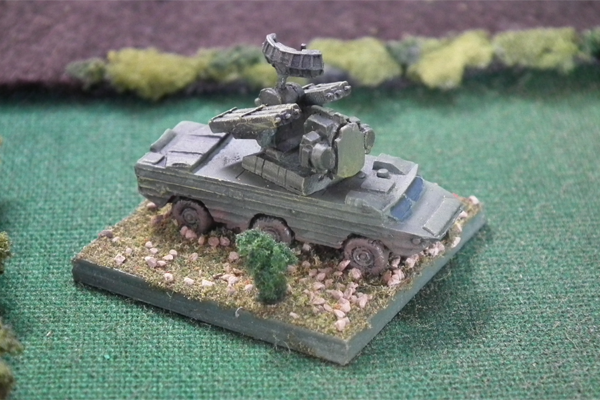
This model is the H&R version of the 9K33M2 Osa, or SA-8b (Gecko) in NATO parlance; it can be easily distinguished from the original SA-8 model by having sealed-in launchers, with six rounds at the ready; the original version had four missiles exposed to the elements. The model is quite good; not quite "square" in places, but reasonably crisp.
The SA-8 was world's first TELAR - a single vehicle combining a missile launcher and its associated fire control radar. The large boat-shaped hull is amphibious, to ensure high operational mobility. In Czechoslovakian service, there was but a single AA regiment equipped with the Osa, the 5th Anti-aircraft Missile Regiment, based at Žatec, which converted to them in 1984, replacing the regiment's S-60 towed 57 mm guns. This regiment was part of the 1st Tank Division; the SA-8b took the place of the usual 2K12s (SA-6b) that the other 1st-echelon divisions were equipped with. The range of the SA-8 is considerably shorter than that of the SA-6, but more than adequate to cover an entire table in an MSH game, even at reduced scale, so I only have one of these models.

Back to my photos top page.